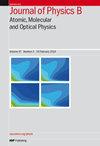Tracking dissociation pathways of nitrobenzene via mega-electron-volt ultrafast electron diffraction
IF 1.5
4区 物理与天体物理
Q3 OPTICS
Journal of Physics B: Atomic, Molecular and Optical Physics
Pub Date : 2024-09-06
DOI:10.1088/1361-6455/ad7431
引用次数: 0
Abstract
As the simplest nitroaromatic compound, nitrobenzene is an interesting model system to explore the rich photochemistry of nitroaromatic compounds. Previous investigations of nitrobenzene’s photochemical dynamics have probed structural and electronic properties. These investigations paint, at times, a convoluted and sometimes contradictory description of the photochemical landscape. We investigate the ultrafast dynamics of nitrobenzene triggered by photoexcitation at 267 nm for the first time using a structural probe with femtosecond time resolution. Our probe complements previous measurements of nitrobenzene’s electronic structure evolution and aids in determining the photochemical dynamics with less ambiguity. We employ megaelectronvolt ultrafast electron diffraction to follow nitrobenzene’s structural evolution within the first 5 ps after photoexcitation. We observe ground state recovery within通过兆电子伏特超快电子衍射跟踪硝基苯的解离路径
作为最简单的硝基芳香族化合物,硝基苯是探索硝基芳香族化合物丰富的光化学过程的有趣模型系统。以往对硝基苯光化学动力学的研究主要探究其结构和电子特性。这些研究有时对光化学景观的描述错综复杂,有时相互矛盾。我们利用飞秒时间分辨率的结构探针,首次研究了 267 纳米波长光激发下硝基苯的超快动力学。我们的探针补充了之前对硝基苯电子结构演变的测量,有助于确定光化学动力学,减少模糊性。我们利用兆电子伏特超快电子衍射跟踪硝基苯在光激发后最初 5 ps 内的结构演变。我们通过非绝热动力学观察到基态在 160±60 fs 内恢复。根据实验信号与分子动力学模拟的比较,我们排除了三重流形的大量存在。此外,我们在所研究的时间窗口内没有观察到硝基苯的碎裂,这表明之前观察到的光碎裂反应发生在振动 "热 "基态,其时间尺度大大超过 5 ps。
本文章由计算机程序翻译,如有差异,请以英文原文为准。
求助全文
约1分钟内获得全文
求助全文
来源期刊
CiteScore
3.60
自引率
6.20%
发文量
182
审稿时长
2.8 months
期刊介绍:
Published twice-monthly (24 issues per year), Journal of Physics B: Atomic, Molecular and Optical Physics covers the study of atoms, ions, molecules and clusters, and their structure and interactions with particles, photons or fields. The journal also publishes articles dealing with those aspects of spectroscopy, quantum optics and non-linear optics, laser physics, astrophysics, plasma physics, chemical physics, optical cooling and trapping and other investigations where the objects of study are the elementary atomic, ionic or molecular properties of processes.

 求助内容:
求助内容: 应助结果提醒方式:
应助结果提醒方式:


